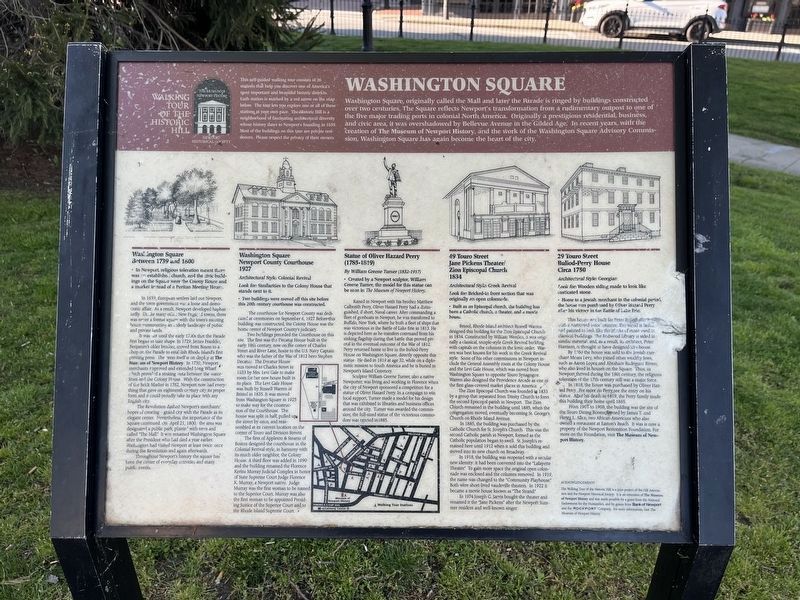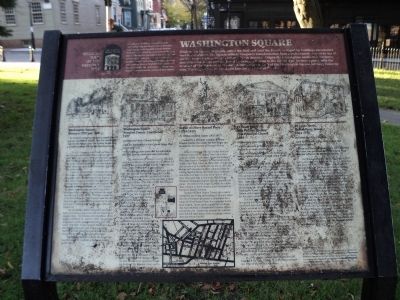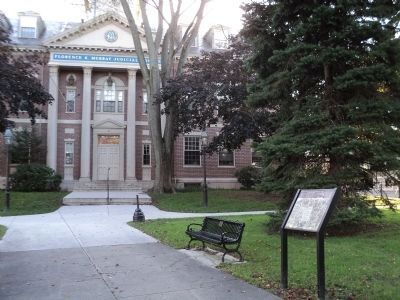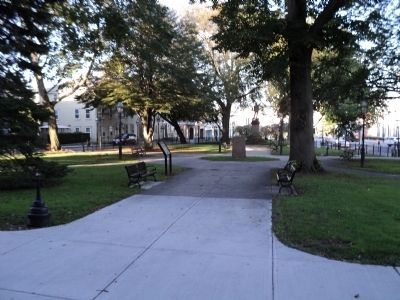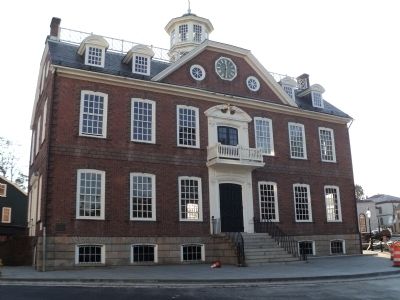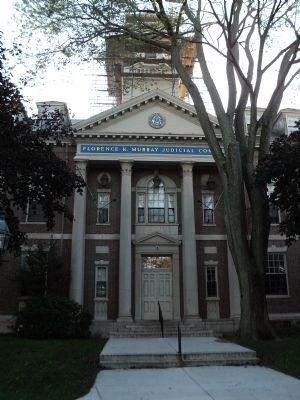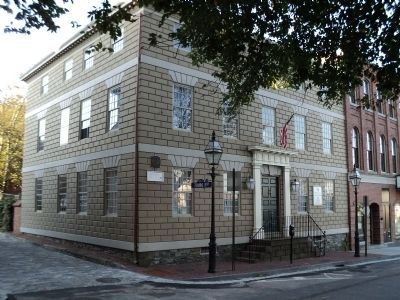Newport in Newport County, Rhode Island — The American Northeast (New England)
Washington Square
Walking Tour of the Historic ill
— The Museum of Newport History, Newport Historical Society —
Washington Square, originally called the Mall and later the Parade, is ringed by buildings constructed over two centuries. The Square reflects Newport’s transformation from a rudimentary outpost to one of the five major trading posts in colonial North America. Originally a prestigious residential, business, and civic area, it was overshadowed by Bellevue Avenue in the Gilded Age. In recent years, with the creation of The Museum of Newport History, and the work of the Washington Square Advisory Commission, Washington Square has again become the heart of the city.
Washington Square
Between 1739 and 1800
• In Newport, religious toleration meant there was no established church and the civic buildings on the Square were the Colony House and a market square of a Puritan Meeting House.
In 1639, European settlers laid out Newport and as a result, Newport developed haphazardly. Unlike many England towns, there was never a central area surrounding an orderly landscape of public and private lands.
(Note: some of the text in the above paragraph is illegible and may not be transcribed accurately.)
It was not until the early 1700s that the Parade first began to take shape. In 1729, James Franklin, Benjamin’s older brother moved from Boston to a shop on the Parade to establish Rhode Island’s first printing press. The press itself is on display at The Museum of Newport History. In 1739, Newport merchants improved and extended Long Wharf which provided a striking vista between the waterfront and the Colony House. With the construction of the Brick Market in 1762, Newport now had everything that gave an eighteenth century city its proper form and it could take its place with any English city.
The Revolution dashed Newport’s merchants’ hopes of creating a grand city with the Parade as its elegant center. Nevertheless, the importance of the Square continued. On April 21, 1800, the area was designated a public park planted with trees and called “The Mall.” It was renamed Washington Square after the President who died a year earlier. Washington had visited Newport at least twice back during the Revolution and again afterwards.
Throughout Newport’s history the Square has been the center of everyday activities and many public events.
Washington Square
Newport County Courthouse
1927
Architectural Style : Colonial Revival
Look for : Similarities to the Colony House that stands next to it.
• Two buildings were moved off this site before the 20th century courthouse was constructed.
The courthouse for Newport County was dedicated at ceremonies on September 6, 1927. Before this building was constructed, the Colony
House was the home center of Newport County’s judiciary.
Two buildings preceded the Courthouse on this site. The first was the Decatur House built in the early 18th century, now on the corner of Charles Street and River Lane, home to the U.S. Navy Captain who was the father of War of 1812 hero Stephen Decatur. The Decatur House was moved to Charles Street in 1833 by Mrs. Levi Gale to make room for her new house built in its place. The Levi Gale House was built by Russell Warren of Bristol in 1835. It was moved from Washington Square in 1925 to make way for the construction of the Courthouse. The house was split in half, pulled up the street by oxen and reassembled at its current location on the corner of Touro and Division Streets. The firm of Appleton & Stearns of Boston designed the courthouse in the Colonial Revival style in harmony with its much older neighbor, the Colony House. A third floor was added in 1990 and the building was renamed the Florence K. Murray Judicial Complex in honor of State Superior Court Judge Florence K. Murray, a Newport native. Judge Murray was the first woman to be named to the Superior Court. Murray was also the first woman to be appointed Presiding Justice of the Supreme Court and to the Rhode Island Supreme Court.
Statue of Oliver Hazard Perry
(1785-1819)
By William Greene Turner (1832-1917)
• Created by a Newport sculptor,
William Greene Turner, the model for this statue can be seen in The Museum of Newport History.
Raised in Newport with his brother Matthew Calbraith Perry, Oliver Hazard Perry had a distinguished, if short, Naval career. After commanding a fleet of gunboats in Newport, he was transferred to Buffalo, New York, where he built a fleet of ships that was victorious in the Battle of Lake Erie in 1813. He is depicted here as he transfers command from his sinking flagship during that battle that proved pivotal in the eventual outcome of the War of 1812. Perry returned home to live in the Buliod-Perry House on Washington Square, directly opposite his statue. He died in 1819 at age 32 while on a diplomatic mission to South America and he is buried in Newport’s Island Cemetery.
Sculptor William Greene Turner, also a native Newporter, was living and working in Florence when the city of Newport sponsored a competition for a statue of Oliver Hazard Perry. In a campaign to win local support, Turner made a model for his design that was exhibited in libraries and business offices around the city. Turner was awarded the commission; the full-sized statue of the victorious commodore was erected in 1885.
49 Touro Street
Jane Pickens Theater/
Zion Episcopal Church
1834
Architectural Style : Greek Revival
Look for : Bricked-in front section
that was originally an open colonnade.
• Built as an Episcopal church, the building has been a Catholic church, a theater, and a movie house.
British Rhode Island architect Russell Warren designed this building for the Zion Episcopal Church in 1884. Constructed by William Weeden, it was originally a classical, temple-style Greek Revival building with capitals on the columns in the Ionic order. Warren was best known for his work in the Greek Revival style. Some of his other commissions in Newport include the General Assembly room at the Colony House and the Levi Gale House, which was moved from Washington Square to opposite Touro Synagogue. Warren also designed the Providence Arcade, one of the first glass-covered market places in America.
The Zion Episcopal Church was founded in 1833 by a group that separated from Trinity Church to form the second Episcopal parish in Newport. The Zion Church remained in the building until 1885, when the congregation moved, eventually becoming St. George’s Church on Rhode Island Avenue.
In 1885, the building was purchased by the Catholic Church for St. Joseph’s Church. This was the second Catholic parish in Newport, formed as the Catholic population began to swell. St. Joseph’s remained here until 1912 when it sold this building and moved into its new church on Broadway.
In 1918, the building was reopened with a secular new identity; it had been converted into the “Lafayette Theater.” To gain more space, the original open colonnade was enclosed and the column removed. In 1919, the name was changed to the Community Playhouse. Both were short-lived vaudeville theaters. In 1922, it became a movie house known as “The Strand.”
In 1974, Joseph G. Jarvis bought the theater and renamed it the “Jane Pickens” after the Newport Summer resident and well-known singer.
29 Touro Street
Buliod-Perry House
Circa 1750
Architectural Style : Georgian
Look for : Wooden siding made to look like rusticated stone.
• Home to a Jewish merchant in the colonial period, the house was purchased by Oliver Hazard Perry after his victory in the Battle of Lake Erie.
This house was built for Peter Buliod about 1750 with a rusticated wood exterior. The wood is fashioned and painted to look like the bricks of stone used in classical buildings. The Redwood Library is sided in similar material and, as a result, its architect, Peter Harrison, is thought to have designed this house.
By 1760, the house was sold to the Jewish merchant Moses Levy, who joined other wealthy jews, such as Aaron Lopez and Abraham Rodrigues Rivera, who also lived in houses on the Square. Thus, as Newport thrived during the 18th century, the religious toleration of the 17th century still was a major force.
In 1818, the house was purchased by Oliver Hazard Perry. For more on Perry see the entry on his statue. After his death in 1819, the Perry family made this building their home until 1865.
From 1901 to 1908, the building was the site of the Touro Dining Room owned by James T. and Henry J. Allen, two African Americans who also owned a restaurant at Eastons Beach. It [was] is now a property of the Newport Restoration Foundation. For more on the Foundation, visit The Museum of Newport History.
Erected by Newport Historical Society.
Topics. This historical marker is listed in these topic lists: Architecture • Arts, Letters, Music • Colonial Era • Industry & Commerce • War of 1812. A significant historical month for this entry is April 1851.
Location. 41° 29.398′ N, 71° 18.815′ W. Marker is in Newport, Rhode Island, in Newport County. Marker is on Washington Square, on the left when traveling east. Marker is located in front of the courthouse. Touch for map. Marker is in this post office area: Newport RI 02840, United States of America. Touch for directions.
Other nearby markers. At least 8 other markers are within walking distance of this marker. Eisenhower Park (a few steps from this marker); The Colony House (a few steps from this marker); Wilbour-Ellery House (within shouting distance of this marker); The Colony House / The State House (within shouting distance of this marker); Perry (within shouting distance of this marker); Buliod-Perry House (within shouting distance of this marker); The Famous Letter by President George Washington (about 300 feet away, measured in a direct line); The Letter from Moses Seixas (about 400 feet away). Touch for a list and map of all markers in Newport.
More about this marker. Pictures of Washington Square, the Newport County Courthouse, the Statue of Oliver Hazard Perry, the Jane Pickens Theater/Zion Episcopal Church and the Buliod-Perry House appear at the top of the marker. A map of the Walking Tour of the Historic Hill in Newport is at the bottom of the marker.
Credits. This page was last revised on May 11, 2023. It was originally submitted on October 20, 2011, by Bill Coughlin of Woodland Park, New Jersey. This page has been viewed 918 times since then and 17 times this year. Photos: 1. submitted on May 10, 2023, by Devry Becker Jones of Washington, District of Columbia. 2, 3, 4, 5, 6, 7. submitted on October 20, 2011, by Bill Coughlin of Woodland Park, New Jersey.
